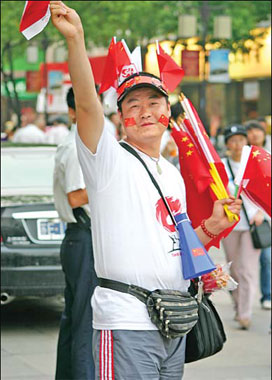SUZHOU, Jiangsu: Along small rivers crisscrossing this ancient city stand centuries-old brick houses with dark roofs and white walls.
Now locals who have lived here for generations are almost as familiar with the hawkers knocking on their doors as they are with each other.
 Zhou Guangru sells flags in Suzhou on Saturday. [China Daily]
Zhou Guangru sells flags in Suzhou on Saturday. [China Daily] |
The new faces hording through the alleys are those of salesmen and women following the Olympic torch around China and selling Chinese, and white Olympic, flags at 2 yuan ($0.29) a pair, as well as sticky miniature paper-flags at 0.5 yuan a piece.
"There are about 10,000 of us who sell flags along the route of the torch relay - much larger than that of torchbearers," Zhou Guangru, who came from Shenzhen in Guangdong province, said.
Only three weeks ago the young man was a designer at a mold factory in Shenzhen.
But when he made more than 7,000 yuan a day after joining friends selling flags several days ahead of the Olympic flame's arrival on May 8, a career change was imminent.
"I was shocked. By designing molds I earned about 4,000 yuan a month, which was one evening's income of selling flags," he said.
Zhou quit the design job the next day and has been following the Olympic flame ever since.
"I can pick up a regular job again in future, but there is not much chance of traveling with the sacred flame," he said.
Arriving at a host city a day ahead of the torch, he regularly made a daily four-digit income before the May 12 Sichuan earthquake.
Du, who also sold flags in the streets of Suzhou over the weekend, said that "early birds" like Zhou were the only ones earning well, while "late birds" like him had been losing money.
Du began following the flame only after it arrived in Nanchang on May 16, traveling by train and staying at cheap hotels.
Both Zhou and Du agreed that sales of flags are much better in small-and-medium-sized cities such as Suzhou, Jiangsu province, and Shaoxing, Zhejiang province, than in metropolises like Shanghai.
"Governments of large cities gave away many free flags and people there were pickier - they thought our flags were ugly," Zhou said.
Suppliers driving truckloads of flags along the relay route receive about 30 percent of the vendors' revenue.
"We are the small fishes and those people are the whales," Zhou noted. "They must have made millions and millions of yuan."